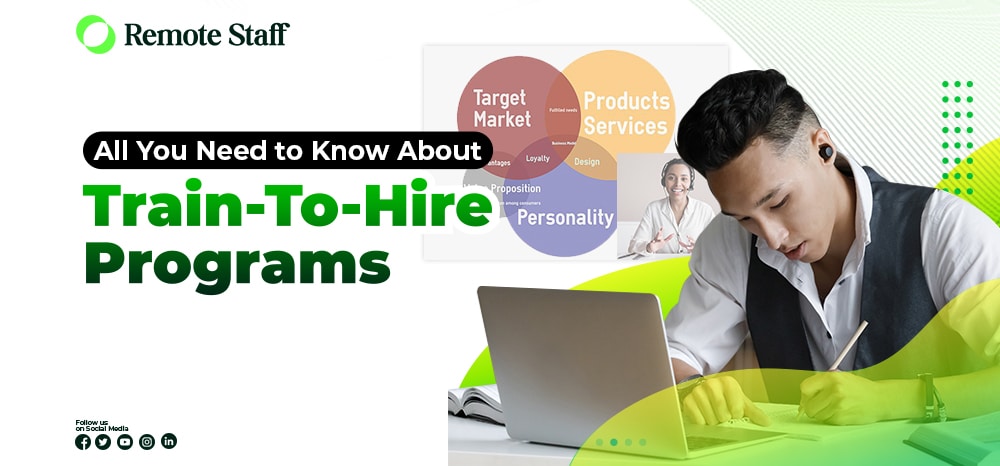One of the main obstacles faced by employees, beginner and experienced alike, today in getting good jobs is a lack of skills. Yes, there are jobs today that don’t require much training and experience; but not everyone prefers working in these online jobs now, do they?
But why is that? Doesn’t college teach these skills already? Unfortunately, the sad reality is that getting a degree doesn’t mean you get the skills that go with it. With how fast technology and businesses evolve today, it’s easy for skills you’ve learned previously to be rendered obsolete. This forces employers to choose between training new employees vs. hiring skilled workers.
A recent solution to this problem is having companies change their hiring and training process to train-to-hire programs. Essentially, train-to-hire programs aim to prepare employees for work by honing their skills and hiring them based on the result.
Want to know more about this new way of hiring and training employees? Then this article’s for you. Here, I will discuss train-to-hire programs, their pros and cons, and whether or not they are an effective way to help workers learn work skills.

What Are the Train-To-Hire Programs?
Let’s begin by discussing what train-to-hire programs are. Train-to-hire programs are a way companies can improve the quality of the applicants they’re getting by training them first. Once they have finished their training, employers can pick from the best candidates to hire. Having this program also saves employers money and time onboarding their employees.
Of course, employers aren’t the only ones benefitting from train-to-hire programs. Applicants can further hone their existing skills or learn new ones while having an opportunity to work to boot. In addition, if they do get hired, they can immediately start working and won’t need too many onboarding sessions.
And thanks to modern technology, employers now have an easier time training their applicants on the skills they need. We now have zoom calls and online resources employers can use to train prospective applicants. These online tools make physical meetings unnecessary unless the employees’ training requires it.

Advantages of Train-To-Hire Programs.
There are several advantages that train-to-hire programs offer. These are:

It Helps Applicants Gain Confidence and Skills for Work.
One of the main advantages that train-to-hire programs have over a hire-then-train program is it gives both the skills and confidence they need for work. Sure, you can also gain skills in the latter, but this requires your employer to hire you first. Even if you didn’t get hired in a train-to-hire program, you still gain essential work skills.
In addition to this, the promise of training before working also gives applicants a confidence boost to apply for a job. It tells them that as long as they’re willing to learn everything they need for the job, they have a chance of getting it.

Train-To-Hire Programs Opens More Jobs to Unskilled Applicants.
This list won’t be complete without this. Train-to-hire programs help solve the problem of applicants lacking the right skillset by having companies train them themselves. Of course, having a degree remains a great advantage, but having this hiring and training process helps close the gap.

These Programs Ensure Companies Get Skilled Employees.
Using train-to-hire programs also allows companies to ensure their hired employees are skilled in their jobs. As I previously mentioned, what you’ve learned in college isn’t always applicable in real work. So having that knowledge, plus company training, helps companies mold their new hires into the employees they need.

Disadvantages of Train-To-Hire Programs.
Despite these advantages over the traditional hire-then-train program, the train-to-hire program does have some drawbacks. These are:

Even if You Attend the Train-To-Hire Program, Your Employer May Still Not Hire You.
The most glaring issue with train-to-hire programs is that even if you finished the program, your employer may still not hire you. You still need to pass the company’s assessment before you are hired. So, what happens if you don’t meet the requirements? Well, your employer won’t hire you, then.
This part of the train-to-hire program can turn off many applicants, especially those who desperately need a job. After all, why should put time and effort in this if the company may not hire you anyway?

The Question of Receiving Payment During This Program.
Another issue for applicants trying this program out is payment. The problem with a train-to-hire program is that unscrupulous companies can use this to get essentially free labor out of their applicants.
And before you say it employers, no, experience doesn’t count as payment. The skills they’ve learned during their training won’t pay their bills nor feed them.

Train-To-Hire: Yay or Nay?
After discussing what the train-to-hire program is and its pros and cons, the question now is, is it worth shifting over to? Well, yes and no. Yes, this new hiring and training process helps open jobs to applicants who want them but don’t have some of the skills yet. And, it also allows companies to get more skilled workers to fill vacant positions.
However, a train-to-hire program doesn’t promise you a slot in the company, even if you finish the program. This means that you could be spending time and effort for a position you won’t get. You may not even receive payment for your efforts too. In that case, why not just apply for an internship, right?
Do note Remote Staff doesn’t offer this work program yet. But we do offer our full support when you’re starting your online job.

